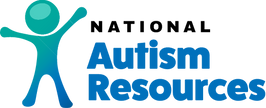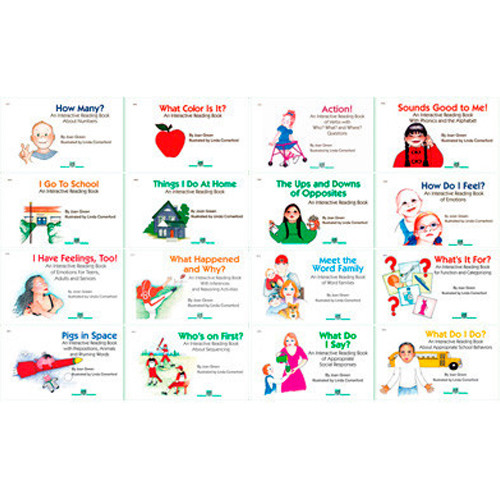
Product Details
Use the complete set of 16 Interactive Reading books to accomplish IEP goals! This set was created by an autism specialist with years of classroom experience and collaboration with Speech and Language Pathologists across the US. Interactive Reading Books utilize the power of visual strategies so that beginning readers can learn to associate pictures with words. Students move and attach picture cards with hook and loop fasteners to match, identify, label, sequence and create sentences while learning to read. Various books in the set support phonological, vocabulary, and comprehension skills. The books are fun and rewarding for children with and without special needs.
How to Use Interactive Reading Books:
Begin by removing the library of picture pages from the front of the book and lay them out on your work space. Leave the sentence pages on the binding rings. Choose from the following suggestions:
-
Activity 1: Matching- Remove the picture cards from the library pages and have the students return them by matching picture-to-picture.
-
Activity 2: Picture Identification- Ask the student to give you or point to a named picture.
-
Activity 3: Picture Labeling- Hold up a picture and ask the student(s) “What is it?”
-
Activity 4: Ask and Answer Questions based on the individual book- What do you do when you are hungry? (eat) Where is the dog? (In front of the log.) Who can lick the ice cream? (She can lick the ice cream.) Why is he climbing the ladder? (To get the box)
-
Activity 5: Sequencing pictures into sentences with assistance. Read sentences aloud while pointing to the words and point to the squares where the pictures should go. Remove the picture cards for the sentence you have just read and give the pictures to the student to put in the correct sequence. Assist as needed. Re-read the sentence together.
-
Activity 6: Sequence pictures into sentences independently- Read a sentence aloud and ask a student to locate and place a picture on the appropriate square. Ask the student to read the picture sentence to you, if non-verbal, re-read the sentence to reinforce receptive language.
-
Activity 7: Have students read the whole book with pictures.
-
Activity 8: Have students read books without pictures.
-
Activity 9: When the student can consistently read each sentence, take the sentence pages off the rings and rearrange their order. Ask them to read the book in a new order.
-
Activity 10: When you are done, have the student return the picture cards to the library pages by matching pictures to pictures.
Learning Topics of 16 books included in this set:
-
How Many? Student will: Match number to quantity/ quantity to number; will read number words 1-12. (How Many? Two Shoes)
-
-What Color is It? Teaches color concepts, reading color words, sequencing language and reading sentences. (“The hat is green”)
-
I Go to School: Sequence picture/word cards to create and read simple sentences based on a young child's school day. (“I read books”)
-
Things I Do At Home: Use picture/word cards to create and read simple sentences based on a young child's day at home. (“I play with toys”)
-
Action: Teaches action verbs and pronouns by posing questions about Who? What? and Where? (“Where can he dig?” Create and read answer, “He can dig in the sandbox.”)
-
Sounds Good to Me! All the letters of the alphabet and identifying beginning sounds in words. (“The letter “B” sounds like balloon.”)
-
The Ups and Downs of Opposites: Pictures teach and visually demonstrate the concept of opposites. (“The dishes were dirty” “The dishes were clean.”
-
How Do I Feel? Teaches children vocabulary to identify and label their emotions. Sample sentences allow children to fill in and express their feelings. Blank pages are used to create sentences based on an individual child's experiences. (“ I feel _____ when I go someplace new.”)
-
I Have Feelings, Too: Allows older individuals such as teenagers, adults and seniors to express their feelings, too. (I feel _____when you say you will come, and you don't.”)
-
What Happened and Why? Look at pictures and make inferences; reason what might have happened and why. Each page asks a question, then provides an explanation. (“What did she bake?” “She baked the cookies.”)
-
Pigs in Space: Teaches prepositions, animals and rhyming words. (“The mouse is in the house” “The dog is in front of the log.”)
-
Who's On First? What happens first, next and last? Sequence the pictures and read the sentences. (First: “She is running in the race.” Next: “She is crossing the finish line.” Last: “She is getting an award.”)
-
Meet the Word Family: Identify rhyming words. (rug/bug/mug; bat/mat/hat)
-
What's it For? Teaches the function of objects and categorizing. (“Where did I sit?” “I sat on a bench, a couch and a chair.”) The function of the objects is to sit, the category is furniture.
-
What Do I Say? Teaches appropriate social responses. (Someone says, “You look very nice today!” What do I say? “Thank-you!”)
-
What Do I Do? Teaches appropriate school behavior. (I need to go to the bathroom. What do I do? “I ask the teacher if I can go. I come right back to class when I am done.”)
This set of books is great for developing communication, speech, reading skills and more. They were created to address common IEP goals in the areas of speech and language, academic, and social emotional development. With instructions on the inside cover of each book,7 levels of activities allow for a range of ages and developmental abilities. The books capitalize on visual learning styles which are helpful to many children, especially those with ASD and other developmental disabilities. The books are also helpful to English Language Learners and Deaf or Hard of Hearing students because pictures and sentences provide visual vocabulary and syntax cues. Pictures can be used to demonstrate comprehension non-verbally.
These laminated books are bound with binder rings so that pages can be reordered or removed as desired. Following the instructions page, each book features full color 2" x 2" Velcro backed pictures and different scenario pages. Books can be used in a group, one-on-one, or independently.
Warranty Information: China
Size: 8.5 x 5 x 2 inches
Ages: 3 and up.














